#harry bellaver
Explore tagged Tumblr posts
Text
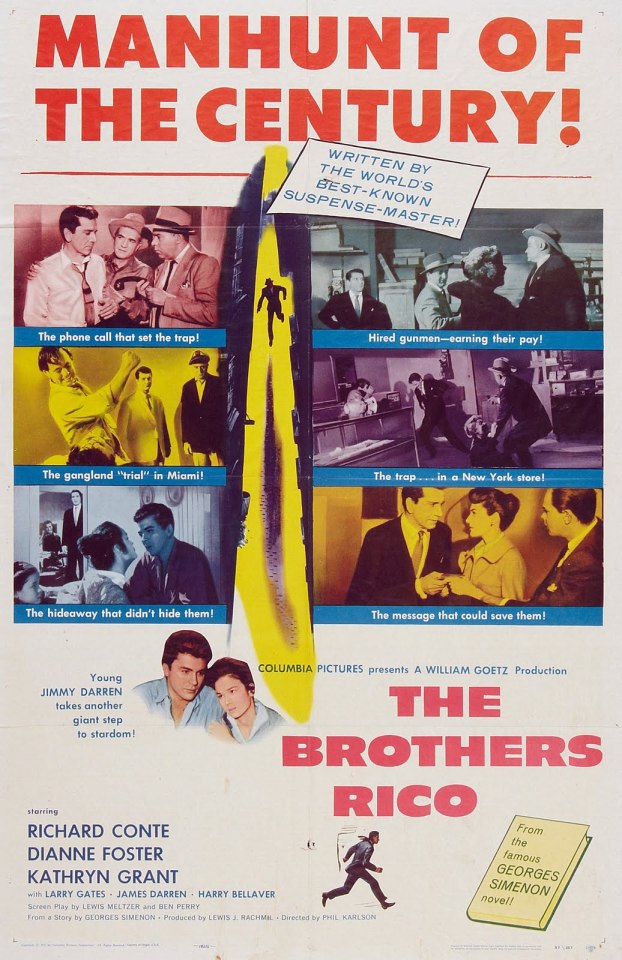

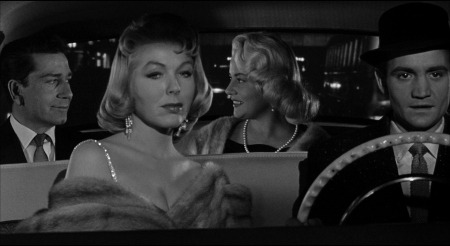
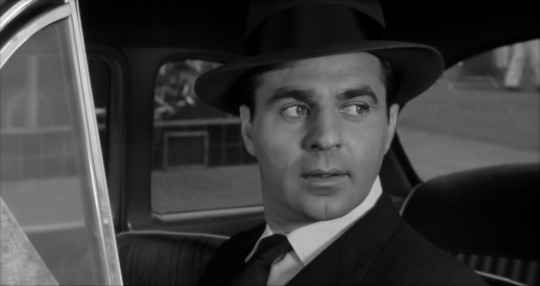
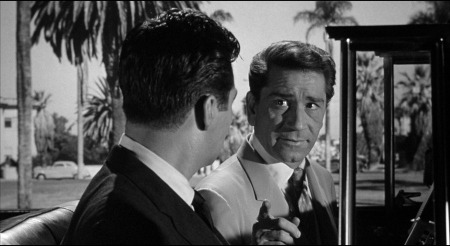
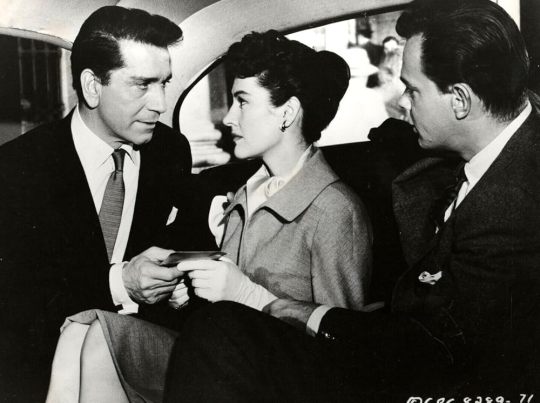
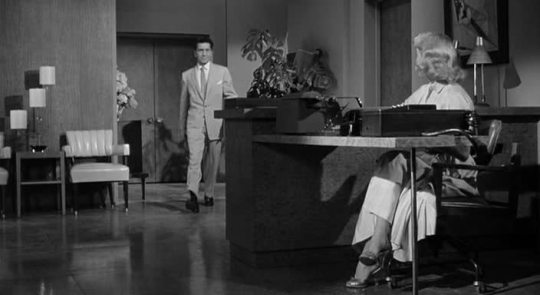

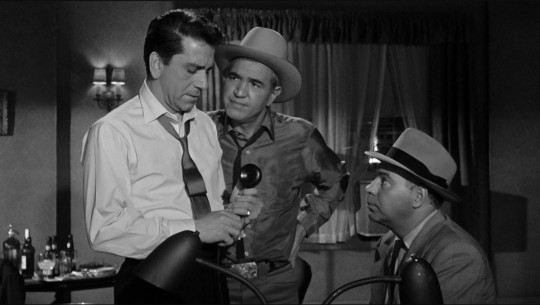

The Brothers Rico (1957)
"Okay, okay, so nobody's blaming you! Let's just say something happened way back, huh? So maybe I am gonna die. But, Eddie, you've got even bigger troubles. You're gonna live."
#the brothers rico#1957#film noir#american cinema#phil karlson#lewis meltzer#ben perry#georges simenon#richard conte#dianne foster#kathryn grant#larry gates#james darren#argentina brunetti#lamont johnson#paul picerni#harry bellaver#paul dubov#william phipps#richard bakalyan#mimi aguglia#US noir adaptation of a Simenon novel; i haven't read this one i dont think but I'd bet good money the book doesn't feature the same#syrupy sweet (and frankly quite implausible) ending. that aside‚ this is very decent stuff indeed. it's character led‚ rather than being#too plot heavy‚ allowing Conte (an old favourite of mine since he stole The Four Just Men tv series away from his international co stars)#to shine in his role as a former mob accountant gone straight but dragged‚ by younger brothers‚ back into the grist of it all#he's brilliant‚ particularly in the early domestic scenes with Foster which are genuinely very sweet and charming‚ with a realism and#natural rhythm that this kind of film so often fails to find in contrast to the stylized violence and hyper cool dialogue of the more macho#setpieces (not that i don't enjoy those too!). nor is Conte alone; this is a good film for actors‚ and every part down to the most minor of#middlemen‚ henchmen and goons (and there's a lot of those here) feels like a fully realised‚ honest creation by a talented actor#the melodrama comes a little thick in the back half and as said the very ending is.. far fetched. but definitely a superior whole of a film
13 notes
·
View notes
Text













From the Golden Age of Television
Season 1 Episode dated April 1, 1952
Not For Publication - 88 Keys to Freedom - DuMont - April 1, 1952
Drama
Running Time: 30 minutes
Written by David Hill
Produced by
Directed by
Stars:
Jerome Cowan as Steve Collins
Harry Bellaver as John "Punky" Zavackas
Jon Silo as Lychek
Donald McKee as Warden Moran
Grant Sullivan as Pete Menko
Fred Catania as Guard
The video file from which these screenshots were taken was of very poor quality resulting in images that aren't as clear as I'd like.
2 notes
·
View notes
Text
BLUE COLLAR:
3 Auto Workers
Pull heist against their union
But find corruption
youtube
#blue collar#random richards#poem#haiku#poetry#haiku poem#poets on tumblr#haiku poetry#haiku form#poetic#richard pryor#harvey keitel#yaphet kotto#ed begley jr.#harry bellaver#paul schrader#Leonard schrader#Sydney A. Glass#George memmoli#Lucy Saroyan#Youtube
2 notes
·
View notes
Text




Secret dressing room passage from The House on 92nd Street (1945)
#secret passage#secret room#the house on 92nd street#1945#40s movies#1940s film#propaganda movie#william eythe#signe hasso#harry bellaver#henry hathaway#set design#movie sets#spy movie#b&w
0 notes
Text









Blue Collar (Paul Schrader, 1978)
Cast: Richard Pryor, Harvey Keitel, Yaphet Kotto, Ed Begley Jr., Harry Bellaver, George Memmoli, Lucy Saroyan, Lane Smith, Cliff De Young, Borah Silver, Chip Fields, Harry Northrup, Leonard Gaines. Screenplay: Paul Schrader, Leonard Schrader. Cinematography: Bobby Byrne. Production design: Lawrence G. Paull. Film editing: Tom Rolf. Music: Jack Nitzsche.
5 notes
·
View notes
Photo

Ethel Merman shot a bull’s eye last night with Annie Get Your Gun. For verve and buoyancy, unslackening, there has seldom if ever been a show like it. It would not be a bad idea to declare an annual Merman Day of all May 16ths in the future.
William Hawkins in the New York World-Telegram, 1946
On May 16, 1946, Irving Berlin’s Annie Get Your Gun opened at the Imperial Theater. It was a huge hit and would run for 1,147 performances.
Photo: Ethel Merman, Daniel Nagrin, and Harry Bellaver in Annie Get Your Gun, Frank Bauman for Look magazine via MCNY
#New York#NYC#vintage New York#1940s#Frank Bauman#Ethel Merman#Annie Get Your Gun#Daniel Nagrin#Harry Bellaver#musical theater#drama#musicals#Broadway#reviews#Irving Berlin#theater#May 16
24 notes
·
View notes
Photo

#no way out#richard widmark#linda darnell#stephen mcnally#sidney poitier#mildred joanne smith#harry bellaver#stanley ridges#dots johnson#joseph l. mankiewicz#1950
33 notes
·
View notes
Video
youtube
BLUE COLLAR (1978) Grade: B-
Little long, & I was surprised to read that basically no one got along on set. It's a good scrip[t & will be a great remake today.
#Blue Collar#1978#Drama Films#B#Paul Schrader#Crime Films#Union#Richard Pryor#Harvey Keitel#Yaphet Kotto#Ed Begley Jr.#Harry Bellaver#George Memmoli#Chip Fields#Detroit#Milton Selzer#Motor City
3 notes
·
View notes
Photo

The Old Man and the Sea (1958). An old Cuban fisherman's dry spell is broken when he hooks a gigantic fish that drags him out to sea. Based on Ernest Hemingway's story.
I’m not really into stories about old guys feeling introspective out at sea, which seems to be an oddly enormous subgenre of both literature and film. That said, this movie is okay, and Spencer Tracy proves, as usual, to be remarkably watchable. There’s some lovely cinematography too, which is quite visually compelling. 7/10.
#the old man and the sea#1958#Oscars 31#Nom: Actor#Nom: Score#Won: Score#Nom: Cinematography#ernest hemingway#john sturges#henry king#Fred Zinnemann#Peter Viertel#spencer tracy#Harry Bellaver#america#american#cuba#introspection#adaptation#at sea#7/10
11 notes
·
View notes
Photo

The Kuirassiers [kur-asi-er]
During The No-Maj Second World War and the Global Wizarding War, many Wizarding Families in Europe were desperate to escape from the chaos of both wars. Many were scared that the Nazi’s treatment of Jews could be an omen of how the non-magical community could treat wizards if their world was discovered. With this era being a hard time for anyone to travel only Families of wealth had the best chance of escaping. Many of these families fled to America, being aware of their strict divide between the magical and non-magical community.
Much of the American Wizarding population however would not be too pleased to have so many new foreign citizens as they saw their former ways of frequently fraternizing with No-Majs as a danger to their hidden community. These families were initially excluded from the mainstream American Wizarding Community, unable to find work or shelter. The families that were once respected and wealthy in their motherland were now ostracized and impoverished.
Some of the European families held out and believed they would eventually blend into the American Wizarding Community, some even charming themselves to hide their accents. Other more prideful families however would band together to stand in opposition of blending in. This would become the birth of the first Wizarding Gangs in America.
Seven notable families of Europe would form a powerful brotherhood due to the lack of American Wizards willing to help them. The Krausman, Devereaux, Tallthorn, Villafuerte, Napier, Bellavance, and Burgess families would form the Brotherhood in 1938 that they would title “The Kuirassiers”. The first intention of the Kuirassiers was to return themselves to their former wealthy lifestyles. Of course coming to America they all had plans of how they would provide for their families once they settled in the new country, but without the trust of Americans and inability to interact with No-Majs this was a lost hope. Now that they had an alliance between each other they felt more protected to preform more unethical ways of acquiring money.
The Tallthorn Family, who were a long line of celebrated Potioneers in Europe, planned to open an Apothecary in New York. But due to the change of circumstances they subsequently sold their ingredients and potions on the Blackmarket to support the Kuirassiers. And the Burgess Family twins, Murcuria and Diomedo, were extremely cunning and would often pick-pocket No-Majs with the help of the Confudus Charm. Vivienne Bellavance, being a finalist in the 1919 French Dueling Championship, taught her new comrades everything they’d need to know about combative magic incase they were caught by Aurors. These minor offenses would grow as the Kuirassier’s greed and resentment towards Americans would.
In 1941, the Kuirassiers robbed the Chicago Wizarding Nighclub, The Proud Pixie, under the guise of masks. The attack started with the Kuirassiers throwing a combustible Drowsiness Draught into the club causing all the attendants to fall into magically induced sleep. They then stole all money and valuables from both the club and the club goers. This was the onset of the Kuirassiers committing more extreme crimes. As the gang continued to rise to power and wealth they gathered the interest of American witches and wizards who also desired wealth and authority or protection. The Kuirassiers initially turned away the volunteers finding it ironic that these Americans wanted to work for them, but then discussed the benefits it would have to followers.
The Kuirassiers began to allow witches and wizards to join their gang starting at the lowest rank, where if they wanted to make it in officially they would have to preform all three Unforgivable Curses on an innocent victim (usually a kidnapped No-Maj). With some of their new members being wizards and witches of influence in America they created a disguise for Kuirassiers, the disguise would be ornate masks that were both luxurious and horrifying. The mask were a symbol of how much dirty money the Original Families had made (a slap in the face to Americans who had turned them away) and also a symbol that would induce fear. The ranking identification of the Kuirassiers was simple, the more opulent the mask the higher the rank, with the Inner Circle Heads having the most lavishness. Upon confiscating the mask of captured Kuirassiers, the Department of Magical Law Enforcement found that the mask were heavily enchanted to be see through for the wearer. This was coupled with an enchantment that caused anyone who isn’t loyal to the Kuirassiers puts one of the mask on they will be inflicted a lethal curse.
This is the time when the Kuirassiers started to gain territory in low income communities occupied by witches and wizards across the north eastern States, who they would offer “protection” from other gangs for a price (however the protection was often from the Kuirassiers themselves). The Kuirassiers had become a serious threat to MACUSA who’s Magical Law Enforcement Department became their biggest foe.
The Kuirassiers intended to continue their gang’s Inner Circle through their children who they forbade to go to Ilvermorny and instead obtained private tutors for them (who were more experienced in Dark Magic than most tutors) and would also be taught by their parents to resent Americans for their discrimination. The leadership of the gang would stay within the original seven families (the seven families having arranged marriages and having children together) with the closest an outsider getting is Captain of Infantry.
In modern day the Kuirassiers are still the most prominent Organization in America’s Wizarding Underground having ties in the Blackmarket, prostitution and gambling. None of the original Family Heads are still alive with the first to pass being Duke Napier, who would start the tradition of a Inner Circle Head passing down their mask to their Successor, in this case Napier’s first daughter Samoanna Napier. The Kuirassiers may have a new generation of leaders but their reign over the Wizarding Underground has not wavered and are still one of MACUSA’s biggest adversaries.
#harry potter#harry potter headcanon#headcanon#america#american#united states#wizarding gang#macusa#Krausman Family#Devereaux Family#Napier Family#Villafuerte Family#Bellavance Family#Tallthorn Family#Burgess Family#magical history#magic in north america#1930s#1940s#Kuirassiers#famous wizards#famous witches
11 notes
·
View notes
Photo

"No Way Out" (1950) is a brilliant noir film debuting the acting career of legendary Sidney Poitier and starring an excellent cast that includes Richard Widmark, Linda Darnell, Stephen McNally, and Mildred Joanne Smith. The movie also features Ruby Dee and Ossie Davis in their first film together. By 1950, black actors with significant roles in Hollywood films were still uncommon, particularly in non-stereotypical roles such as medical doctors. Moreover, the Race Era was ending, so the opportunities for black actors mostly faded. However, a year before, James Edwards starred in "Home of the Brave," and Juano Hernadez starred in "Intruders in the Dust," which set a new trend for black male actors in Hollywood. In addition, the presence of Mildred Smith as the supportive and loving wife living in a middle-class family added to this new narrative. These subtle differences were giant leaps for Hollywood as it was risky for them to show black people other than stereotypical servants, field hands, mammies, Uncle Tom's, or slow-talking dimwits. So how does "No Way Out" differ from some of its precessors? "Home of the Brave" is about a black man in a war setting. "Lost Boundaries" and "Pinky" had a 'passing for white' theme with different story premises. "No Way Out" tells the story of a black man in a white man's everyday world as a professional. Darryl F. Zanuck produced the 1949 film "Pinky" and enthusiastically backed "No Way Out" after reading Lesser Samuels' script and soon assigned Joseph L. Mankiewicz to add his expertise in filmmaking. Zanuck wanted both movies made as they dealt with two different subject matters of black life. The search for a suitable actor for the black doctor Luther Brooks was a nationwide search by Zanuck and casting director William Gordon. Several dozen actors auditioned, but eventually, Gordon selected 23-year-old Poitier for the role. Ruby and Ossie Davies starred in the Broadway and American Negro Theatre play, "Anna Lucasta" for the West Coast road company, while Potier played lead in the Eastern show. However, the head of the American Negro Theatre of the New York Actors Guild, Fredrick O'Neal, was among the biggest supporters of the movie. He remarked: "It's the most honest (scripts) I have ever read on the subject. The resemblance between this story and life is strictly truthful." Overall, this movie has many layers, and if you're critical like I am, you'll see many social components addressed on race, class, and patriarchy. It's a beautiful cinematographic film with intense emotion and drama. The film dives into how hate blinds people from the truth, even when their life depends on it. Richard Widmark did a superb job in his challenging role as the hate-filled low-class criminal mourning the death of this brother and the symbolic end to his truths. And Linda Darnell, the bewildered damsel trying to figure out the world around her while struggling with her prejudices, did an excellent job in the movie. I highly recommend this film and all of its glory and energy. You will be satisfied. Director: Joseph L. Mankiewicz Writers: Joseph L. Mankiewicz, Lesser Samuels, Philip Yordan (contract writer) Starring Sidney Poitier, Richard Widmark, Linda Darnell, Stephen McNally, Mildred Joanne Smith, Dots Johnson, Ossie Davis, Ruby Dee, Harry Bellaver, Stanley Ridges, Maude Simmons, Amanda Randolph Storyline When a white patient in a hospital dies under the care of a black intern (Sidney Poitier), the victim's racist brother (Richard Widmark) seeks to destroy the doctor's career. Although the hospital's idealistic Chief Resident (Stephen McNally) tries to diffuse the escalating tension, the victim's ex-wife (Linda Darnell) seems to go along with the vengeance-seeker until she realizes she's on the wrong side. https://www.daarac.ngo https://www.daaracarchive.org/2017/09/no-way-out-1950.html Available on Blu-ray (Region B only). https://www.amazon.com/Way-Blu-Ray-combo.../dp/B07BX6Q789 Available on DVD (Region A), but it's out of print. Also, on streaming services. https://www.amazon.com/Way-Out-Fox-Film-Noir/dp/B000CNE08S
8 notes
·
View notes
Text
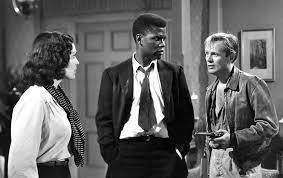
Linda Darnell, Sidney Poitier, and Richard Widmark in No Way Out (Joseph L. Mankiewicz, 1950)
Cast: Sidney Poitier, Richard Widmark, Linda Darnell, Stephen McNally, Mildred Joanne Smith, Harry Bellaver, Stanley Ridges, Dots Johnson, Ossie Davis, Ruby Dee, Amanda Randolph, Maude Simmons. Screenplay: Joseph L. Mankiewicz, Lesser Samuels. Cinematography: Milton R. Krasner. Art direction: George W. Davis, Lyle R. Wheeler. Film editing: Barbara McLean. Music: Alfred Newman.
Although its treatment of race relations in America seems naive today, No Way Out stands up as a solid drama about an issue that in the post-war years was finally receiving the attention from Hollywood filmmakers that it had too long deserved. It also launched the career of Sidney Poitier as well as, in smaller roles, Ossie Davis and Ruby Dee. The plot hinges on the novelty of a Black doctor, Luther Brooks (Poitier), serving as an intern in hospital in a large city. When two brothers, Ray (Richard Widmark) and Johnny Biddle (Dick Paxton) are admitted to the prison ward of the hospital after being shot by the police during a robbery, Brooks notices that Johnny's symptoms are not just that of a leg wound; suspecting some sort of mental impairment, Brooks does a spinal tap, during which Johnny dies. Ray Biddle has already demonstrated his racist animosity toward Brooks, and claims that he killed his brother. An autopsy would determine whether Brooks's suspicion that Johnny's death was caused by an undiagnosed brain tumor is correct, but Ray won't allow it, and he's backed up by his brother George (Harry Bellaver) and initially by Johnny's ex-wife, Edie (Linda Darnell). She once had an affair with Ray, but she loathes him and has done what she can to escape the poor-white neighborhood, Beaver Canal, where she grew up and the Biddles still live. Ray spurs the rabble-rousers of Beaver Canal to start a race riot, but they are met with resistance from the Black neighborhoods. The film is a little over-plotted: The crux of the plot, the autopsy, gets resolved in a way that isn't entirely convincing, and the confrontation of Brooks and Ray Biddle arrives in what's almost a coda, as an anti-climax. Widmark is allowed to overact in the role of Ray, and Poitier has yet to acquire the confident presence that made him a star. The best performance in the film comes from a deglamorized Darnell, who gives Edie a real toughness and vulnerability, suggesting that her inclination to do the right thing is at war with her experience growing up in Beaver Canal. The film's portrayal of raw racism still has the power to shock: We rarely hear white actors use the N-word today, even when their roles as bigots might seem to require it, and I flinched when a white woman spat in the face of Poitier's character. It's weaker in the treatment of racial violence: No one on either side seems to have any guns.
5 notes
·
View notes
Photo

Passages - Naked City
John McIntire (June 27, 1907 – January 30, 1991)
James Franciscus (January 31, 1934 – July 8, 1991)
Harry Bellaver (February 12, 1905 – August 8, 1993)
Horace McMahon (May 17, 1906 – August 17, 1971)
Paul Burke (July 21, 1926 – September 13, 2009)
2 notes
·
View notes
Text
The Old Man and the Sea *** (1958, Spencer Tracy, Felipe Pazos, Harry Bellaver) - Classic Movie Review 9995
The Old Man and the Sea *** (1958, Spencer Tracy, Felipe Pazos, Harry Bellaver) – Classic Movie Review 9995
Director John Sturges’s 1958 adventure drama The Old Man and the Sea stars Spencer Tracy, who sailed into Best Actor Oscar and Golden Globe nominations for his portrait of The Old Man, the Ernest Hemingway seaman hero, a lifelong fisherman who fantasises about catching the big fish.
Though set-bound and slow moving, Sturges’s earnest film of Ernest Hemingway’s barely filmable story is made very…
View On WordPress
0 notes
Photo

The Old Man and the Sea (1958) YAŞLI ADAM VE DENİZ IMDb Address: http://www.imdb.com/title/tt0052027/?ref_=nv_sr_1 Yapımı : 1958 - ABD Tür : Macera | Dram Süre : 86 Dakika. Yönetmenler : John Sturges, Henry King Oyuncular : Spencer Tracy, Felipe Pazos, Harry Bellaver... Film Özeti Balıkçılık ile yaşamını sürdüren ancak 84 gündür hiç balık tutamayan Kübalı ihtiyar adam, günler sonra karşısına çıkan devasa bir kılıç balığını yakalamaya çalışır. Gençlerin dahi altından kalkamayacağı olağanüstü bir mücadele verir. Bu zorlu mücadelede balığa saygı da duymaya başlar. Film, Ernest Hemingway'in 1952'de yazdığı "Yaşlı Adam ve Deniz" romanından sinemaya uyarlamasıdır. Filmin başrol oyuncusu Spencer Tracy, En İyi Aktör Oskar'ına aday gösterilmiş, filmin müzikleri En İyi Film Müziği Oskar'ını almıştır.
0 notes
Text
Affari sporchi
Regia: Mike Figgis , Fred Zinnemann Con: Andy Garcia , Richard Gere , Nancy Travis , Mickey Shaughnessy , Ernest Borgnine , Laurie Metcalf , Jack Warden , Frank Sinatra , Deborah Kerr , Michael Beach , Katherine Borowitz , Philip Ober , William Baldwin , Donna Reed , Richard Bradford , Burt Lancaster , Montgomery Clift , Harry Bellaver , John Dennis , Merle Travis , Tim Ryan , Arthur…
View On WordPress
0 notes